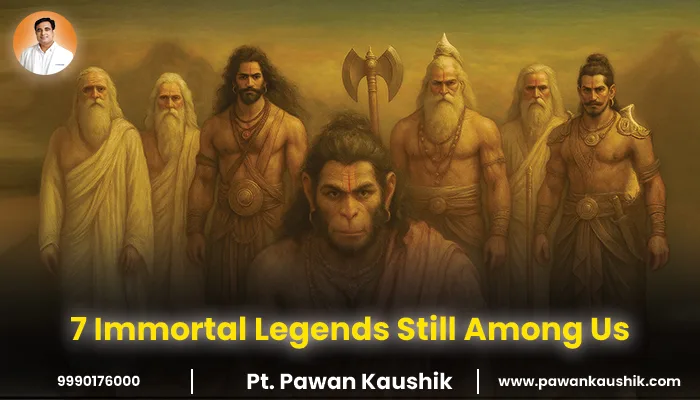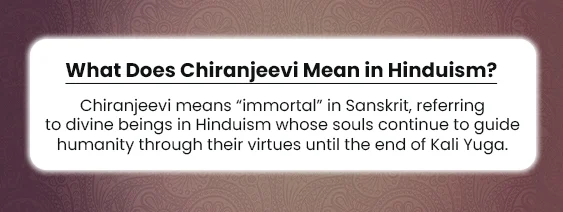 7 Chiranjeevi is a mythological concept in Hindu culture that is found in our ancient texts. According to this concept, there are seven most powerful and divine figures, who will live until the end of the earth. Their presence marks the yuga of Ramayana and Mahabharata (Indian ancient Scriptures), and they will live on earth till the end of the Kaliyug. In this blog, we will explore the seven legends (known as Chiranjeevis) who are revered, and their legacies are unmatched.
7 Chiranjeevi is a mythological concept in Hindu culture that is found in our ancient texts. According to this concept, there are seven most powerful and divine figures, who will live until the end of the earth. Their presence marks the yuga of Ramayana and Mahabharata (Indian ancient Scriptures), and they will live on earth till the end of the Kaliyug. In this blog, we will explore the seven legends (known as Chiranjeevis) who are revered, and their legacies are unmatched.
Who Are the 7 Chiranjeevi?
The following contains the 7 Chiranjeevi names who can never die and they have been granted immortality as either a boon or a curse.The seven immortals of Hindu mythology are:
- Hanuman β The Devotee of Lord Rama
- Vibhishana β The Righteous King of Lanka
- Parashurama β The Warrior Sage
- Ashwatthama β The Cursed Warrior of Mahabharata
- Kripacharya β The Eternal Teacher
- Bali (Mahabali) β The Generous King
- Ved Vyasa β The Author of the Mahabharata
What Does Chiranjeevi Mean in Hinduism?

The term Chiranjeevi is derived from the Sanskrit words Chiram (long) and Jeevi (life), meaning “one who lives long” or “immortal.” In Hinduism, a Chiranjeevi is not merely someone who lives forever in a physical sense but is a soul whose presence continues to influence the world through their actions, teachings, and virtues. These immortals are believed to remain on Earth, guiding humanity through their eternal essence until the end of the current age, known as Kali Yuga.
Why Are the 7 Chiranjeevis Important in Hindu Mythology?
The seven Chiranjeevi are significant because they embody timeless principles that guide human behavior and spiritual practice. Their stories are not just mythological tales but are lessons in devotion, righteousness, wisdom, and sacrifice. By understanding their lives and teachings, individuals can find inspiration to lead lives aligned with dharma (righteousness) and spiritual growth.Also check out our thoughts on Karmic Debts in Astrology

The List of Seven Chiranjeevi Names and Their Legends
Hanuman β The Devotee of Lord Rama
Hanuman, the son of Anjana and Kesari, is renowned for his unwavering devotion to Lord Rama. His strength, courage, and selfless service are legendary. Hanuman played a pivotal role in the Ramayana, assisting Rama in rescuing Sita from the demon king Ravana. Even today, Hanuman is believed to be alive, present wherever his name is chanted with devotion.Vibhishana β The Righteous King of Lanka
Vibhishana, the younger brother of Ravana, chose the path of righteousness over familial ties. He defected to Lord Rama’s side during the battle of Lanka, advising Ravana to return Sita to Rama. After Ravana’s defeat, Rama crowned Vibhishana as the king of Lanka. Vibhishana’s story emphasizes the importance of dharma over personal relationships.Parashurama β The Warrior Sage
Parashurama, the sixth avatar of Lord Vishnu, is depicted as a Brahmin warrior carrying an axe. He is known for ridding the world of corrupt kings 21 times. Parashurama is also the teacher of Bhishma, Drona, and Karna in the Mahabharata. His role underscores the balance between spiritual wisdom and martial prowess.Ashwatthama β The Cursed Warrior of Mahabharata
Ashwatthama, the son of Guru Dronacharya, was a formidable warrior in the Mahabharata. After the war, in a fit of rage, he unleashed the Brahmastra, resulting in the death of the Pandavas’ sons. As punishment, Lord Krishna cursed him to wander the Earth for eternity with an incurable wound. His tale serves as a reminder of the consequences of uncontrolled anger.Kripacharya β The Eternal Teacher
Kripacharya, the royal teacher to both the Pandavas and Kauravas, was known for his impartiality and wisdom. He survived the Kurukshetra war and is believed to still be alive, imparting knowledge to those who seek it. His life exemplifies the virtues of patience and neutrality.Bali (Mahabali) β The Generous King
King Bali, a demon king known for his generosity and devotion, was sent to the netherworld by Lord Vishnu’s Vamana avatar. However, due to his noble heart, Vishnu granted him immortality and the right to return to his people once a year. His return is celebrated as the festival of Onam in Kerala, symbolizing humility and sacrifice.Ved Vyasa β The Author of the Mahabharata
Ved Vyasa, also known as Krishna Dvaipayana Vyasa, is credited with composing the Mahabharata, one of the longest epics in the world. He also compiled the Vedas and authored several Puranas. Vyasa’s contributions to Hindu literature and philosophy are immense, and he is revered as a sage who continues to inspire seekers of knowledge.Beliefs, Temples, and Places Connected to the 7 Chiranjeevi
Many temples and sacred sites are associated with the Chiranjeevi:- Hanuman: Hanuman temples are widespread across India, with notable ones in places like Hanuman Garhi in Ayodhya and the Sankat Mochan Temple in Varanasi.
- Parashurama: Temples dedicated to Parashurama can be found in Kerala and Maharashtra.
- Ashwatthama: There are stories of sightings in regions like Madhya Pradesh.
- Vyasa: Caves in Uttarakhand, such as the Vyasa Gufa, are believed to be associated with him.
- Bali: His return is celebrated during the Onam festival in Kerala.
The Spiritual Meaning Behind the 7 Chiranjeevi
The seven Chiranjeevis represent divine qualities that transcend time:- Hanuman: Devotion and strength
- Vibhishana: Righteousness and loyalty
- Parashurama: Justice and divine anger
- Ashwatthama: Karma and destiny
- Kripacharya: Wisdom and patience
- Bali: Humility and sacrifice
- Ved Vyasa: Knowledge and truth

Conclusion
The 7 Chiranjeevis are not mere mythological figures; they are eternal symbols of virtues that continue to guide humanity. Their stories remind us that qualities like devotion, righteousness, wisdom, and humility are timeless and should be upheld in our daily lives. By reflecting on their lives and teachings, we can find inspiration to lead lives aligned with dharma and spiritual growth.If you’re curious to understand your own spiritual path, karmic journey, or need Vedic guidance based on astrology and mythology, you can book your consultation with Pt. Pawan Kaushik β a renowned best Jyotish in India and Vastu consultant in Delhi. His insights can help you align your life with divine wisdom.
 +91 9990176000
+91 9990176000 +91 9999097600
+91 9999097600
 CALENDAR 2025
CALENDAR 2025











